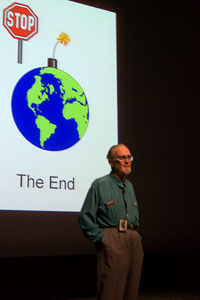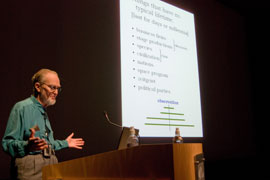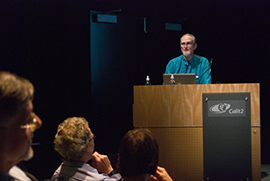Apocalypse When?
Theoretical Physicist, Author Speaks on How Long the Human Race Will Survive
Roxana Popescu | October 19, 2009

Willard Wells is a theoretical physicist who has developed a statistical model that he believes predicts with unprecedented accuracy not just how humanity will collapse, but when.
Four horsemen or one huge asteroid?
A bang or a whimper?
Wrought from on high or caused by humanity itself?
When it comes to predicting how the world will end, most sane people would call all bets off. But there’s sane, there’s insane, and then there’s Dr. Willard Wells, a theoretical physicist who has developed a statistical model that he believes predicts with unprecedented accuracy not just how humanity will collapse, but when.
Before you cash in your 401k, relax.
There’s still a long way to go before the apocalypse.
“In the very long term – many centuries – the odds are about 7 to 3 that our species will survive,” Wells stated.
At the same time, humanity’s future will not be a “smooth ride,” he warned listeners at his talk, which was held in Atkinson Hall last Thursday and hosted by Calit2. Wells was on campus last week to present his ideas, which appear in his new book Apocalypse When? Calculating How Long the Human Race Will Survive.
In an introduction, Larry Carter, a UCSD emeritus professor of computer science, didn’t mince words. The first time he heard about Wells’s theories, he thought, “Oh my God, is this guy a crackpot?”

Humanity’s future will not be a “smooth ride,” he warned listeners at his talk, which was held in Atkinson Hall last Thursday and hosted by Calit2.
But persuaded by Well’s credentials, which include a PhD from Caltech in math and theoretical physics, a career that led him L-3 Photonics and the Caltech/Jet Propulsion Laboratory, and an invention under his belt, Carter gave the ideas a chance. And was intrigued.
Using statistical modeling, Wells has concluded that the human race has a half-life of 8.6 billion “people centuries,” which are measure along the lines of “man-hours.” A half-life, for those non-chemistry majors out there, is the amount of time a substance decays by half. While he did not quantify how many years that actually translates into, he did offer insights into how humanity’s lifespan could be extended – or shortened – by its own activities.
The wrong approach to calculating humanity’s lifespan, he said, would be to do a numerical simulation with risk analysis, the way other scientific predictions are sometimes carried out – simply because the future is too unpredictable. Instead, he proposed a method that looks at two key constants: natural hazards and man-made hazards.
Because humanity will constantly be facing these threats, a good predictor is how easily humanity could withstand each of them.
To probe his hypothesis, Wells took a comparative statistical approach, looking at the survival rates of three very diverse entities: businesses, stage productions, and the human race. Each of these lacks a finite lifespan, and each is made up of members who can prolong the institution even after its individuals die, he explained.

Statistics aside, his ideas contained kernels that even a layperson could relate to. Self-extinction will soon be a feasible scientific outcome, he argued, thanks to advances in genetic engineering, robots and other technologies.
He then performed a series of calculations and presto, he arrived at his magical numbers.
Statistics aside, his ideas contained kernels that even a layperson could relate to.
He was anxious about the changes in technology that lead to an increasing likelihood of disaster.
“Starting about 1950, our world changed forever,” Wells told the crowd. The global population has more than doubled since then, and technology has surged at an unprecedented pace. Self-extinction will soon be a feasible scientific outcome, he added, thanks to advances in genetic engineering, robots and other technologies.
He concluded his talk with the provocative argument that a cataclysm might be actually the best-case scenario for humanity. This is because while such an event would destroy billions of lives, it would also destroy human technology and other methods by which humans could destroy themselves.
“The survival of our species depends on having some cataclysm that wipes out civilization,” he said. “A near extinction event may be doomsday for 4 billion people. However, that cataclysm will probably rescue our species from extinction.”
During his talk, audience members whispered, shook their heads in disbelief or occasionally snickered, but if the liveliness of the question and answer session at the end was any indication, his ideas easily sparked a dialogue.
Jake Whitehill, a graduate student in Computer Science, remains a skeptic.
“I thought it was nonsense,” Whitehill said. “There was nothing in his talk that was remotely provable. There were millions of other data sets he could have used that would have invalidated his own conclusion.”
For his part, Wells seems to have anticipated naysayers. He concluded his talk on a light note, offering an insurance policy for doomsday. “$1,000,000 policy now only $995 annually,” he joked in his final slide.
“So if any of you brought your checkbooks,” Wells added, “we can arrange something after the meeting.”

|